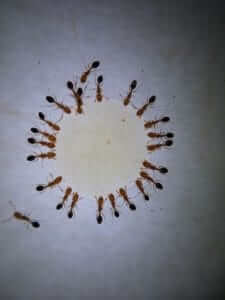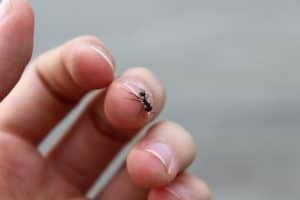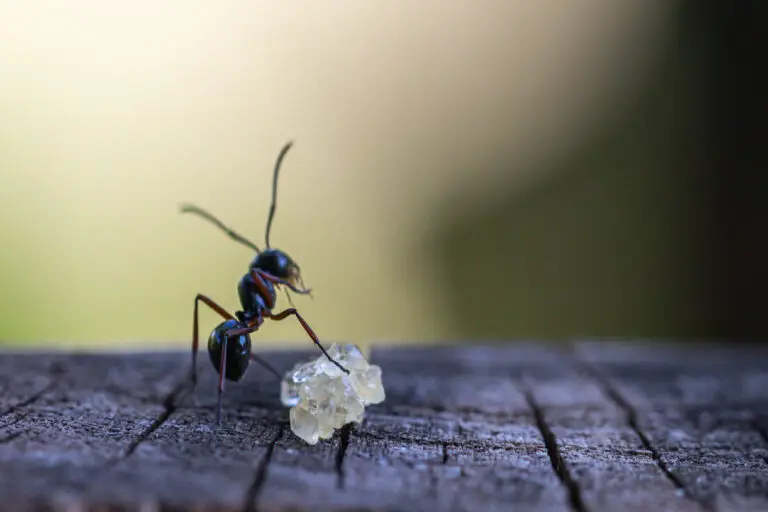What Do Ants Eat Outside & In Your Home?
By: EarthKind
Finding ants in the kitchen is super annoying, but not too surprising. It happens so frequently that many people use the term “kitchen ants” or “sugar ants” to refer to these household pests.
Those names may be commonplace, but they are not scientifically accurate. Technically speaking, there are many different kinds in the world. When it comes to the ones in your house, there are a few types of ants that make up the ‘usual suspects.’
Since the best way to get rid of ants is to understand why they’ve come inside to begin with, let’s talk about the ant diet and what they eat.
Eating Habits
Ant eating habits change based on many factors. The species, the time of year, and the location can all affect their food choices.
During the spring, when ants are reappearing after winter, they are focused on increasing their numbers. This means that they prefer a high protein diet. Once the next generation has hatched from their eggs (an ant life cycle takes a few weeks), they will pursue a high-carb diet.
When it comes to what ants drink, they need water to live. They are attracted to moisture and oftentimes obtain the moisture they need through the foods they eat.
What Do Ants Eat in the Wild?
When ants stay outside where they belong, they find protein by eating live or dead insects or spiders and parts of dead animals. They will use their strong mandibles to tear into these other insects along with their saliva to consume them. For carbohydrates, they will often eat and feed larvae a substance called honeydew. Honeydew is a liquid produced by aphids and scale insects when they feed on plants. Ants and aphids often live in harmony. The ants can protect their honeydew makers from natural predators like lady beetles and get an unlimited food supply in return.

What Do Ants Eat Inside?
When ants trespass indoors, their nutritional needs stay the same, but their favorite foods might be different. It’s possible for them to favor potted plants indoors, still working in harmony with their aphid buddies.
They may also be attracted to small insects that are hidden inside your home, sometimes even finding bed bugs (though rare). However, most that make their way inside are attracted to the tasty treats they can’t get outdoors.
Kitchens are one of the most common places to find ant infestations because they are attracted to all the food. They are opportunistic pests and will start with whatever is easy to get. An uncovered trash can, a sticky spot of spilled juice, or some crumbs that were left under the table are all easy sources of food.
Since these pests are so small, they can get into things you might think are safe. Food packages that aren’t tightly sealed, like boxes of cereal or crackers or open jars of peanut butter, are easily accessible and attractive. They are also attracted to moisture, making kitchen sinks, bathrooms, and appliances like water heaters or washers, hot spots.
How Do They Find Food?
Ants have what’s called chemosenses which is a chemical sensing system that gives them the ability to detect chemicals even at very low concentrations. There are small bristles on the body that work as olfactory receptors that help them easily detect chemicals such as sugars, fats, and proteins.
When they find food, they head straight back to the nest while leaving a trail of pheromones along the way so they can find their way back to the food source. Others will also follow this trail and leave their own pheromones to strengthen the trail.
Different Jobs
Ant colonies are made up of hundreds, or even thousands of ants. Each has a job. The queen ant has only one job and never leaves the colony; she just lays eggs. Worker ants are specialized depending on their jobs. Some workers tend to the queen’s eggs, caring for and feeding the babies. Other workers stay inside the ant nest, digging new tunnels and maintaining the old ones. Others are tasked with exploring new territory and finding food. The ones that find food leave a scent trail for even more workers to follow. Then they carry food back to the colony from the source.
What Do Different Species of Ants Eat?
Odorous House Ants (Dark Brown or Black Ants) – Odorous ants are one of the most common types. They love honeydew, which is a sugary secretion that comes from aphids and mealybugs. They love sugary food crumbs dropped on the ground too. And when they don’t have something sweet, they will eat dead insects.
Carpenter ants – These ants are often confused for termites but have thin abdomens and shorter back wings. Many people assume that Carpenter ants eat wood, but what they actually do is remove wood to create tunnels to their nests. They love honeydew secretion and sugary foods but will also feed on protein, such as dead or living insects, meats, and dog and cat food (or other pet foods) in the house.
Argentine ants – Argentine ants are native to northern Argentina but have migrated worldwide from South America. They will eat a large variety of foods, including sweets, meats, cat & dog food, and sugary drinks. Argentine is a unique species of ant because of how their diets adapt to their environments. Research has shown that they move into new areas and become predators of native ants and other insects like flies and spiders, consuming almost entirely protein. And when there are no longer insects to feed on, they switch to a sugar-water diet and feed on honeydew from aphids.
Fire ants – Fire ants like to stay outside but will come into your house to look for food and water. They are omnivores, so they’ll eat sugars, fats, and protein. Fire ants like to eat meats, greasy foods, dead insects (like worms, spiders, and ticks), honeydew nectar, plants, and plant seeds. They also have strong mandibles and venomous stingers on their abdomen that can immobilize much larger prey, even young songbirds.
Leafcutter ants – You might think that these ants eat leaves, but you’d be wrong! They actually cut pieces off of leaves and take those pieces back to the nest to grow fungus. The fungus then secretes enzymes, which is what they eat! They don’t tend to infest homes but they can cause serious damage outside. For example, they can completely remove the leaves from a small tree in only a day. They are found only in the southern-most states with tropical climates.
Crazy Ants – This type is named for their erratic movements and usually found in warmer southern states. Like most ants, they like sweets, honey, fruit, and honeydew secretions, but they prefer to eat other insects, protein, and grease. They often nest in electronics and outlets to stay warm, which usually causes significant electrical damage.
Pavement Ants – These are usually found on sidewalks and under rocks. They like to eat just about anything; sugary foods, meats, greasy foods, and anything you drop on the kitchen floor. They don’t usually nest inside homes but will enter homes and become a nuisance if they find food inside.
Ghost ants – These can be identified by their white legs and abdomen. They are common home pests and will nest inside but only live in warmer states. They love sweet foods and honeydew, but also eat live or dead insects.
Stop Ants From Coming Into Your Home
Pest control is never easy but it can be done. If you find ants in your house, you should observe them for a minute to see where they are coming from and what they are doing. Once you know how they’re getting in, you can block their entrance and wash away the scent trails they’ve made for their friends. If you see where they are going, you can get rid of the food source or anything else they may be attracted to. Place an ant repellent in the area to help stop them from coming back.
For more ideas on ant control, check out our post on removing them from your home safely.
The #1 rated pest prevention brand.
EarthKind pest repellents are made of fast-acting formulas with plant-powered essential oils. All our products are 100% effective. Guaranteed or your money back.










 day
day